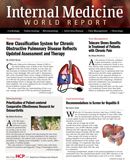Publication
Article
Internal Medicine World Report
Increased Development in Carpal Tunnel Syndrome
Author(s):
As people spend more time sitting and working in front of computer screens, studies have shown the risk of developing carpal tunnel syndrome (CTS) has grown. A team of researchers recently worked to take a deeper look at specific factors and their roles in the development in the condition.

As people spend more time sitting and working in front of computer screens, studies have shown the risk of developing carpal tunnel syndrome (CTS) has grown. A team of researchers recently worked to take a deeper look at specific factors and their roles in the development in the condition.
The study looked at receiver-operating characteristic (ROC) curves as part of the research as well as anthropometric measures. Those measures included a person’s weight, height, waist and hip circumference, as well as wrist depth, among others. Researchers also looked at factors like obesity and hand and wrist ratios. Additionally, the authors noted that as part of their work, they separated some factors by gender.
“The cut-off points of anthropometric measures for the identification of subjects with increased risk of CTS have never been assessed in the general population,” the authors noted. “Hence, we aimed at determining optimal cut-off values of the body, wrist and hand measures and derived ratios in a large sample of subjects of both genders using receiver-operating characteristic curves.”
With a total participant pool of 1,117 patients, the authors reported 250 female patients with CTS and 474 female control group members, as well as 120 cases of the condition and 273 male control group members. Results from the study suggested “low accuracy,” (AUC≤0.64) for the anthropometric measures.
The results were only slightly better with the male group showing “moderate accuracy (AUC 0.75). This was particularly true for some patients regarding hand and wrist ratios. The hand and wrist ratio was not as strong of a contributing factor in female participants or those also identified as obese. “These findings could have occupational implications and deserve further considerations,” the authors said of the male results.
“The estimates from the multivariable models confirmed the well-known associations between the selected variables and the risk of CTS, but the use of multiple predictors did not dramatically improved the diagnostic performance observed for single anthropometric indexes,” the authors noted.
As a result of their findings, the authors determined that the measures considered were not strong enough to serve as diagnostic tools for CTS.
“Even though our findings confirmed the expected associations between several anthropometrics characteristics and the risk of CTS, we found that body/hand measures and their ratios showed limited accuracy for discriminating CTS cases from controls, especially in females,” they said. “The ROC curves showed that for all studied measures it would be necessary to accept a very low specificity in order to have a high sensitivity (>75%) and vice versa. Thus, the anthropometric characteristics seem to have a potential as screening tests for the identification of subjects at high risk of CTS.”






